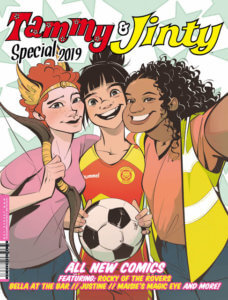In the past, generations of British girls were entertained by comics with names like Sally, Judy, Diana, Debbie, Emma, June, Penny, Sandie, and Tina. The respective title character would serve as a mascot, while each issue contained a collection of stories about the exploits of various young heroines. D.C. Thomson’s Bunty, which ran from 1958 to 2001, was the standard-bearer for the genre, but IPC’s Tammy (1971-1984) and its younger sister Jinty (1974-1981) were respectable rivals. As anthologies, the comics were free to explore a range of genres, with tales of schoolgirl drama sitting alongside more out-there material. Jinty, for example, had a sideline in dystopian science fiction strips like “Fran of the Floods,” “Land of No Tears,” and “The Human Zoo,” all of which have been recently collected as trade paperbacks. Tammy, meanwhile, inherited horror stories from its Gothic sister title Misty.
Now, two of these long-defunct but well-remembered comics are back in action with the Tammy & Jinty Special 2019. The special follows on from Rebellion’s previous revivals, Scream & Misty and Cor!! Buster, and aims to do for classic British girls’ comics what those specials did for horror and humour. The Tammy & Jinty Special kicks off with Emma Beeby and PJ Holden’s “Justine: Messenger of Justice,” a strip starring a character who might be familiar to some as she originated in the first issue of Sally, published in 1969. A schoolgirl equipped with magic artefacts loosely based on Greek mythology, Justine is interesting as a British counterpart to both American superheroes and the magical girls of manga.
Speaking to WWAC, scriptwriter Emma Beeby described how she fell in love with the character despite missing out in her appearances in the original Sally comics. “I didn’t get to read them as I was just a bit too young and missed their era, but I really loved the idea of this character and was given free rein to reinvent her.” The modern reinterpretation does make some changes: Justine now sports modern jeans rather than the flowing Greek robe of the original, and the elderly man who bestowed her magical implements has been replaced with the goddess Athena.
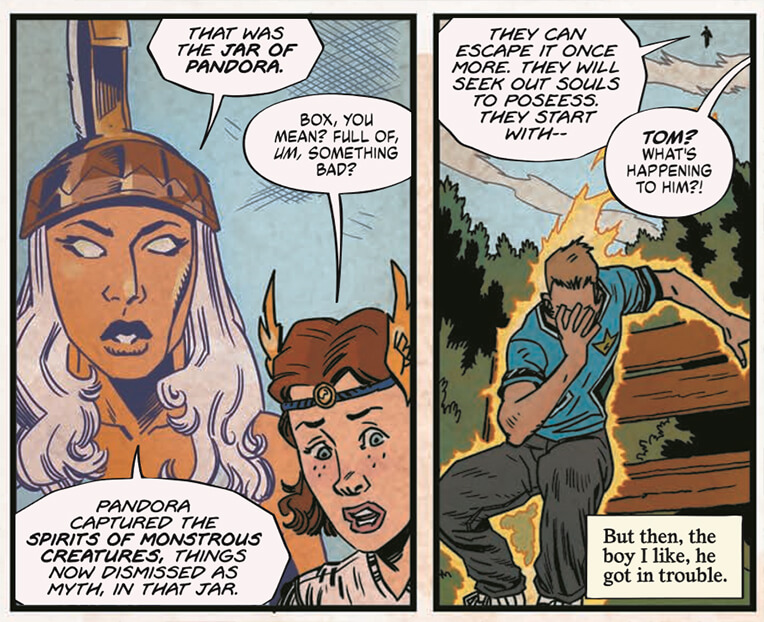
“She has that Spidey/Buffy thing of having to balance superheroing with studying and friends and love interests and family,” says Beeby. “Diving into that, while mashing mythology with modernity, is just so fun. I hope I can get a chance to tell more Justine stories.” Beeby’s storyline sees Justine fighting a Minotaur, which is billed as one of multiple mythological monsters to have escaped from Pandora’s jar—the perfect set-up for more adventures from this character.
Earlier incarnations of Tammy and Jinty used combinations of ongoing series and self-contained stories, and this special features a similar mixture. While Justine is tailor-made to appear in future adventures, most of the strips are one-shots. A number of the special’s done-in-one stories use the tried-and-true concept of youngsters finding magic artefacts or abilities, often learning lessons as their attempts to reshape the world around them do not go to plan.
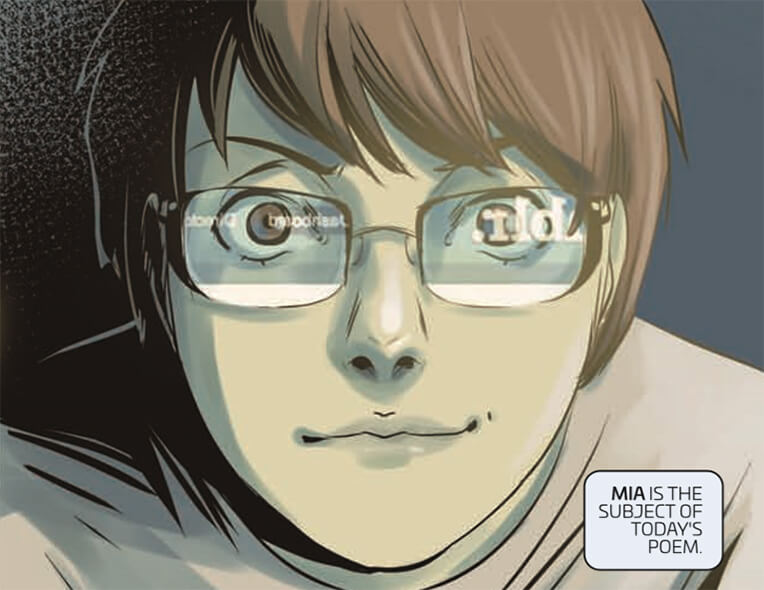
“Maisie’s Magic Eye” by Kate Ashwin and Kel McDonald is about a girl who finds a magic stone that allows her to control minds. She initially uses it to get back at bullies, but later realises that she has become a bully herself. “Duckface” by Rachel Smith and Yishan Li has a similar idea, but is more grounded in the modern world of social media bullying. The heroine discovers that the insulting poetry she writes for her blog has a supernatural effect on its targets, leaving her with a moral quandary. Sarah Millman’s “Speed Demons” is a light-hearted and silly variation on the theme, with a roller derby player resorting to black magic to improve her ability and ending up with a set of monstrous roller skates.
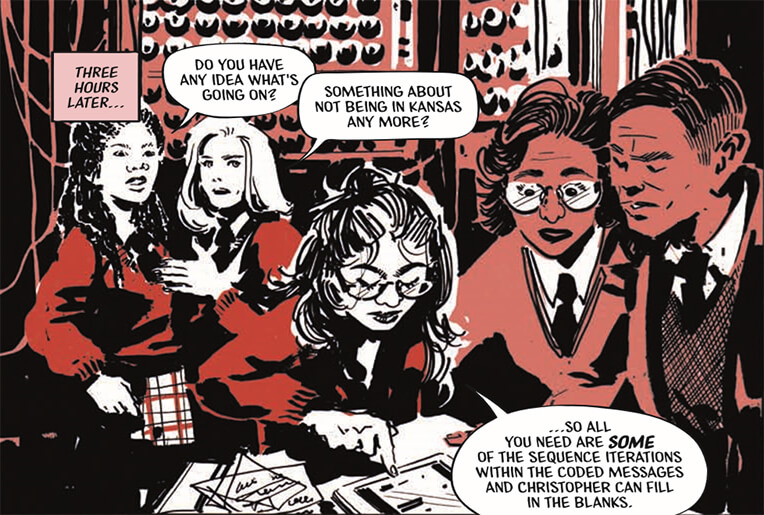
“The Enigma Variation” by writer Grainne McEntee and artist Dani has a more science fictional treatment of the formula. A schoolgirl, bullied for her keen interest in history, finds a time machine that takes her back to meet Alan Turing and Joan Clarke as they work on cracking the enigma code, allowing her to find kindred spirits in these two historical figures. This strip stands out as Dani’s artwork—with its scratched chiaroscuro and monochromatic splashes—hearkens back to the original Tammy and Jinty comics in the seventies and eighties. This is in contrast to most of the other strips in the special, which draw upon a rather different range of influences to earlier girls’ comics.
“In the Cold Dark” by Marr Gibbs and V. V. Glass—a ghost story about two archaeology students who disturb the spirit of an Anglo-Saxon woman—mixes gloomy settings with cartoonish characters, creating an effective but gentle eeriness that is appropriate for the target age group. Meanwhile, in “Affirmative Action”—a science fiction tale about a cyborg girl overcoming a dystopia—writer-artist Andy W. Clift goes for a pop-art style with heavy use of printing dots and primary-coloured space-scapes straight out of Kirby or Ditko.

The remaining two strips in the special use established characters, albeit in heavily revised forms. One is “Rocky of the Rovers” by Rob Williams and Lisa Henke, which is a spin-off from the football comic Roy of the Rovers, itself a revival of an earlier title. Created by writer Rob Williams, artist Lisa Henke, and colourist John Charles, the strip uses a brash, energetic style to tell the story of Roy’s football-loving sister Rocky.
The other revival is “Bella at the Bar,” a fondly-remembered Tammy strip about a struggling working-class girl who wants to be a gymnast. The story by Rachael Ball gives Bella a new friend in Nina, a girl from a posh background who is pressured by her parents to become a gymnast despite preferring street dance. Vanessa Cardinali handles the artwork, depicting Bella with a cartoonish distortion completely unlike John Armstrong’s more realistic illustrations for the original strip, and yet, turns out to be a good fit for the subject matter, the young gymnasts transforming into fluid abstractions.
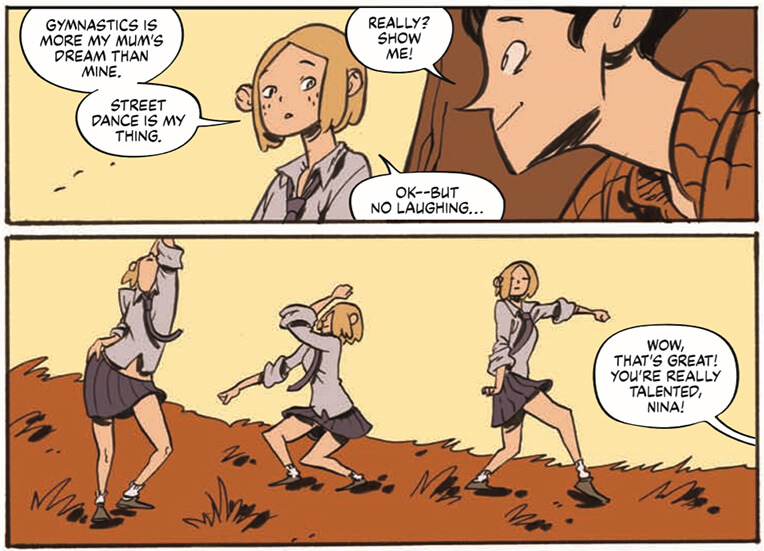
Is there a place for Tammy and Jinty in the contemporary British comics landscape? Michael Molcher, who provides publicity and marketing for brother title, 2000 AD, believes so.
“One of the things that has struck us is just how relevant and modern the comics in our archive can be,” he told us. “Once you get past certain dated elements, it’s remarkable how fresh and rounded many of these characters are. If anything, it feels like modern comics are only just catching up with how British comics used to be. In the special you have old characters such as Bella at the Bar alongside newer ones such as Rocky of the Rovers, but the intent of the strips is still the same—good characters who aspire to overcome great odds and achieve greater things. For some people, maybe, that feels like a new notion because we’ve forgotten how positive these comics used to be?”
The special concludes with a questions-and-answers session where members of the creative team show a varied range of influences. Rachael Ball, who provided a very traditional script for “Bella at the Bar,” unsurprisingly lists Tammy, Jinty, Bunty, and Misty as childhood favourites, while “Speed Demons” creator Sarah Millman cites Dragonball Z and Pokémon as early inspirations. It seems fitting that there would be a degree of manga influence, as the British tradition embodied by Tammy is in many ways a spiritual counterpart to Japan’s shoujo scene.
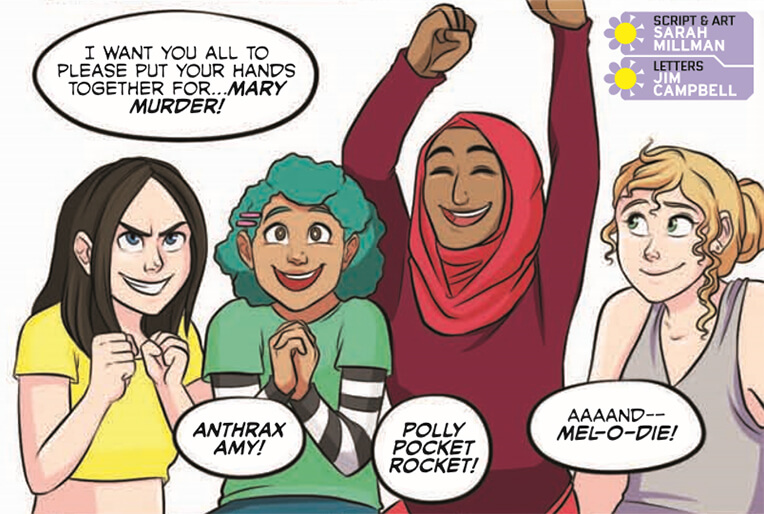
“At last year’s San Diego Comic Con, we had a panel about British girls’ comics, and one of the panelists was Zack Davidson, an award-winning American translator of manga,” says Molcher. “This was the first time he’d read these titles and what struck him was how much they felt and read like manga. There’s such a wide range of subject matter across genres, all with great and well-thought-out characters.”
Molcher suggests that one reason for the demise of the British girls’ comic was that actual comic material gave way to cheaper features relating to pop music and TV personalities, until the comics were closer to teen magazines in content. “Within the space of a decade, girls comics were replaced by teen magazines, which often drew on the rise of women’s magazines such as Cosmopolitan and Elle. It was a slow, steady evolution driven by market forces, but it’s still incredibly sad when you consider the sheer breadth and depth of the content that was being produced.”
The Tammy & Jinty Special 2019 does not go down this path: it is unabashedly a comic, and makes no attempt to present itself as anything else. As with the previous specials put out by Rebellion, it offers a nostalgic treat for anyone old enough to remember the original versions of the comics, but more than that, it aims to spearhead a revival that will attract new generations.
“The response to this special has been phenomenal and we’re busy firming up our plans for next year,” says Molcher. “I’m very happy to say that you can expect more from Tammy & Jinty!”


